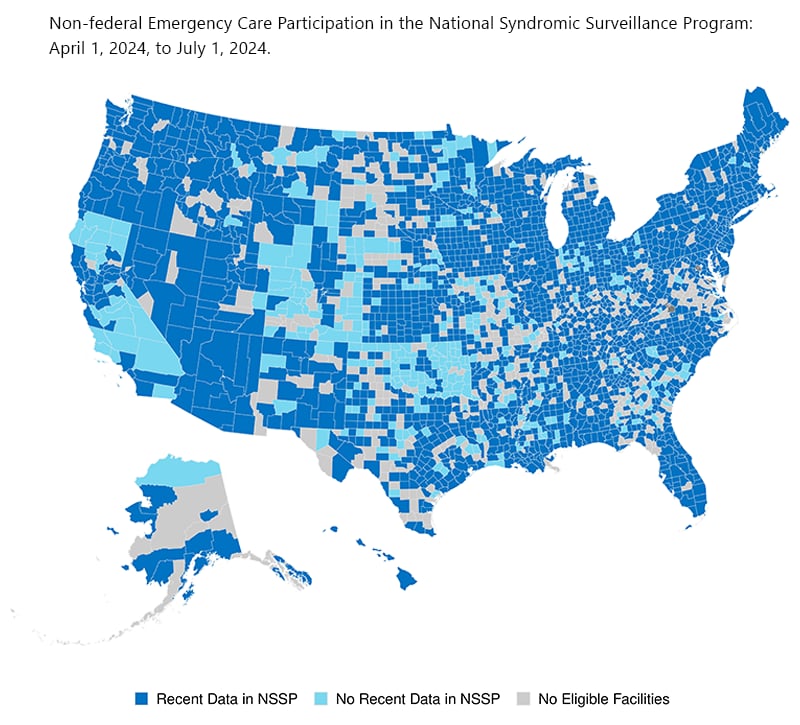What to know
- CDC's support of NSSP is an investment in the health of our nation.
- NSSP provides expertise and technical assistance to public health professionals as we work together to investigate and respond to health threats.
- NSSP strives to embody the values of transparency and collaboration to eliminate siloes and aid decision-making through integrated electronic data.

Integrated data sources to inform decision-making
Integrating data from many sources helps create connected, resilient, adaptable, and sustainable systems. Having complete, accurate, and timely data is an excellent foundation for improving health outcomes. CDC's investment in technology and processes ensures we are ready to respond to public health threats together to improve lives. Data sources used by NSSP include:
- Emergency department (ED) and other health care data
- Commercial laboratory data
- Mortality data
- Department of Defense data from US-based medical centers
- Veterans Affairs medical center data
- Administration for Strategic Preparedness and Response Disaster Medical Assistance Teams data
- National Weather Service data
- AirNow.gov air quality data
- In staging: National Notifiable Disease data
Integrated data inform decision-making, at the same time bringing better information to the public about health threats in their communities. Learn more about our CDC and Partner Dashboards.
Reaching out to NSSP
Syndromic surveillance
Syndromic surveillance provides public health officials with a timely system for detecting, understanding, and monitoring health threats. By tracking symptoms of patients in EDs and other settings—before and after a diagnosis is confirmed, all in near real-time—public health can detect unusual levels of illness to determine whether a response is needed. Public health also uses syndromic data to monitor disease trends.
Syndromic data can serve as an early warning system to protect Americans from respiratory viruses, environmental threats, avoidable injuries, emerging diseases, and more.
Syndromic surveillance is a collaborative effort among local and state health departments, CDC, and partners.
New users
How it works
Here is a high-level view of how syndromic surveillance works:
- People seek treatment.
- The medical facility sends de-identified data—including chief complaint, diagnosis codes, patient characteristics, and location—to state and local health departments or to data aggregators such as Health Information Exchanges.
- Public health departments and Health Information Exchanges contribute data to the NSSP BioSense Platform.
- Public health practitioners, many of whom are part of our community of practice, will access data via the BioSense Platform to conduct surveillance activities for monitoring public health.
This map shows emergency care NSSP facility participation by county:

The role of NSSP
NSSP unites federal partners, local and state health departments, and academic and private sector partners. NSSP provides the infrastructure for data sharing and supports a vibrant community of practice. Together, we use integrated data, captured in near real-time, to protect health and improve the nation's responsiveness to health threats.
NSSP supports syndromic surveillance through:
- BioSense Platform, a cloud-based early detection and monitoring system
- The NSSP Community of Practice, a virtual hub for public health professionals to connect
- Technical and onboarding assistance
- More than 6,900 health care facilities covering 50 states, the District of Columbia, and Guam contribute data to NSSP daily.
- Within 24 hours of a patient’s ED visit, data are available in NSSP for analysis.
- 80% of U.S. emergency departments send data to NSSP, often within 24 hours.
- More than 9.6 million electronic health messages are received by NSSP every day.
By the numbers
- More than 6,900 health care facilities covering 50 states, the District of Columbia, and Guam contribute data to NSSP daily.
- Within 24 hours of a patient’s ED visit, data are available in NSSP for analysis.
- 80% of U.S. emergency departments send data to NSSP, often within 24 hours.
- More than 9.6 million electronic health messages are received by NSSP every day.
